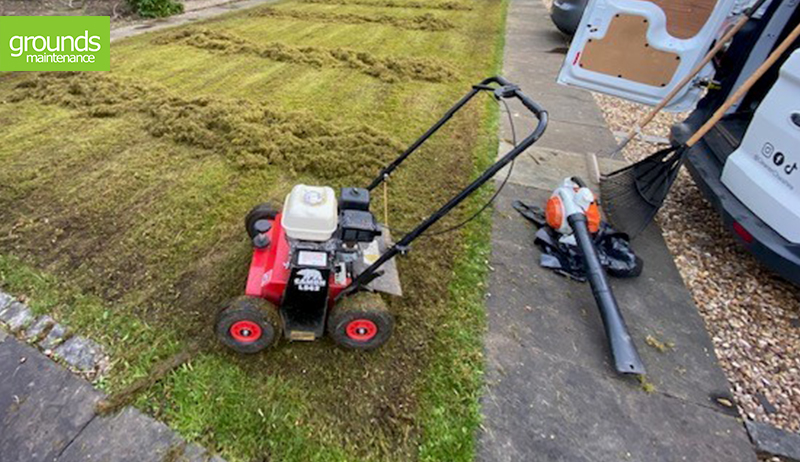
How to Scarify your Lawn – Like a Professional
What is lawn scarification?
Lawn scarification is the process used to remove excessive amounts of thatch from a lawn and is an important part of lawn care and maintenance. Scarifying is done using a mechanical lawn scarifier which has adjustable rotating steel blades to cut the thatch out without destroying the healthy grass. In some cases, they can even penetrate the soil below the surface to improve the aeration and the quality of the grassroots.
It’s important to note that there are no products available to kill off moss and thatch, this needs to be manually removed from your lawn. That said, you can get a head-start and use iron sulphate to blacken the moss beforehand.
Why should I scarify my lawn?
Scarification is necessary when thatch in the lawn becomes excessive and begins to damage the grass. Too much thatch on a lawn can suffocate rather than protect plants, stopping them from getting the necessary light, water and air that they need. In itself thatch isn’t a bad thing – a layer about 0.5-1cm thick is fine – anything thicker will begin to damage the grass and removing the build-up will improve the health of your lawn ultimately making it more resilient.
How do I scarify my lawn?
This depends on the size. Small lawns can be scarified by hand using a spring tine rake but can be quite tiring and do not produce as good results as a mechanical Scarifier. If you have a small or medium size garden, a pedestrian Scarifier (i.e. one that you push along like a lawnmower) can be very effective. Larger gardens may require the use of a ride-on Scarifier which can be hired from any plant hire companies.
As scarifying is only a one-off job, or once every few years I hire them from Brandon Hire Station. Brandon Hire is nationwide and hires out Camon Petrol Lawn Scarifier – which come highly recommended, are very easy to use and remove nearly enough all moss and thatch. Find your nearest Brandon Hire Station. Petrol scarifier hire ranges between £30-60 for a weekend / full weeks hire.
What is thatch?
Thatch occurs naturally but as with many plants, over time old grass leaves and stems die away and are replaced with new ones. As the dead material can be slow to decay it sits in a spongy layer under the green sward of the lawn. Having some thatch under the top surface of your lawn is not necessarily a bad thing as it acts as a protective layer, shielding both soil and grass plants from the elements. In addition, the correct amount can also give the surface of your lawn a firmer, thicker look and feel.
How can I tell if my lawn needs scarifying?
Too much thatch on a lawn will give your grass a spongy feel when you walk on it. You should be able to see a layer 0.5-1cm thick when you look at the sides of your turf – any more than this is excessive and unhealthy for your lawn. You can take a core sample from your lawn to assess how thick the thatch is, and see how extensively your lawn needs scarifying.
When should I scarify my lawn?
Ideally, scarification should be carried out in the late summer and early autumn as this provides better results in terms of recovery. We advise that scarifying is carried out between mid-August and October because the warmth and moisture present in the soil in the autumn will help the lawn to recover more quickly. You can also scarify your lawn in the springtime, but this should only be light rather than heavy duty as the summer months can be detrimental if it is particularly hot, dry weather. Scarifying should not be done during winter – doing so at this time of year is more likely to damage your lawn than improve it.
Ground temperature is equally important under this heading as it’s essential the temperature is above 8 degrees.
How often should I scarify my lawn?
Most lawns will need to be scarified, but some require more than others if they are prone to a thatch build-up. It depends entirely on the type of lawn, soil and how the natural bacteria is working in your individual environment. Fine lawns containing creeping fescue will generally build up thatch more quickly, while lawns with high levels of ryegrass produce far less. Over fertilising, bad mowing techniques and grass grown in poor quality soil may make your lawn more susceptible to thatch.
What happens afterwards?
Apart from your lawn looking pretty scary, getting an ear full from your partner or if you’re doing this on a commercial basis (complaints from nosey hobby gardeners and passers-by)! Although it can be a bit of a shock at first, your lawn will recover amazingly quickly and look all the better for it. The rate at which your lawn recovers can vary depending on weather conditions and the initial quality of your lawn – however, be patient as it will be worth it.
Any thatch that has been cut away should be removed (raked up and removed from the lawn) – it makes good compost which is an added bonus! Other lawn treatments can be carried out at the same time including aeration, over-seeding and top dressing with sand and loam which all help with recovery.
What are the benefits of scarifying my lawn?
- Removes harmful levels of thatch
- Prunes grass roots encourage growth
- Allows water to reach the soil
- Allows air to reach the sward
- Allows nutrients to reach the grass plants
- Removes moss and dead weeds
- Reduces the likelihood of future moss problems
- Improves the health of your lawn
- Refreshes tired or poor-quality lawns
- Good preparation for over-seeding
Personal notes
Scarify your lawn at least once every two years, you will be surprised at how much thatch you will have inside your lawn. If you are doing this on behalf of a commercial customer, pre-empt numerous complaints, I dread doing this in public spaces as you will always get one nosey person, passer-by, hobby gardener, someone with zero clue what you’re doing and they will make sly comments, remarks or full-blown complaints, making a show of themselves, even though they have zero clue that you are doing the lawn the world of good! Don’t be tempted to buy one of the cheaper £60-£80 scarifier from Aldi or Screwfix, these may sound great and have amazing reviews, but they won’t give you desired results. It’s always best to hire a professional scarifier such as the Camon Petrol Scarifier from Brandon Hire or any other hire shops – these are of a commercial grade and will give professional results.
External links: The external links are being provided as a convenience and for informational purposes only; they do not constitute an endorsement or an approval of any of the products, services or opinions of the corporation or organisation. We do not bear any responsibility for the accuracy, legality or content of the external site or for that of subsequent links. Contact the external site for answers to questions regarding its content.








